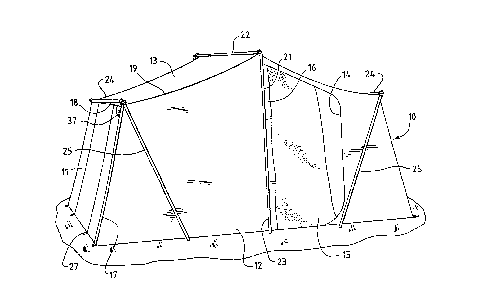Une partie des informations de ce site Web a été fournie par des sources externes. Le gouvernement du Canada n'assume aucune responsabilité concernant la précision, l'actualité ou la fiabilité des informations fournies par les sources externes. Les utilisateurs qui désirent employer cette information devraient consulter directement la source des informations. Le contenu fourni par les sources externes n'est pas assujetti aux exigences sur les langues officielles, la protection des renseignements personnels et l'accessibilité.
L'apparition de différences dans le texte et l'image des Revendications et de l'Abrégé dépend du moment auquel le document est publié. Les textes des Revendications et de l'Abrégé sont affichés :
| (12) Brevet: | (11) CA 2115090 |
|---|---|
| (54) Titre français: | AERATEUR DE TENTE |
| (54) Titre anglais: | VENTILATOR FOR TENT |
| Statut: | Périmé et au-delà du délai pour l’annulation |
| (51) Classification internationale des brevets (CIB): |
|
|---|---|
| (72) Inventeurs : |
|
| (73) Titulaires : |
|
| (71) Demandeurs : |
|
| (74) Agent: | BORDEN LADNER GERVAIS LLP |
| (74) Co-agent: | |
| (45) Délivré: | 1998-09-01 |
| (22) Date de dépôt: | 1994-02-07 |
| (41) Mise à la disponibilité du public: | 1995-06-18 |
| Requête d'examen: | 1995-04-18 |
| Licence disponible: | S.O. |
| Cédé au domaine public: | S.O. |
| (25) Langue des documents déposés: | Anglais |
| Traité de coopération en matière de brevets (PCT): | Non |
|---|
| (30) Données de priorité de la demande: | ||||||
|---|---|---|---|---|---|---|
|
La présente invention a pour objet une tente pourvue d'une ouverture destinée à recevoir un ventilateur et pratiquée dans un des coins. La tente comporte une paire de panneaux latéraux qui sont joints l'un à l'autre par une couture latérale et un panneau supérieur qui est joint aux panneaux latéraux par une couture supérieure. L'un des panneaux latéraux comporte une ouverture située au voisinage des coutures latérale et supérieure; une moustiquaire recouvre l'ouverture. Une jupe fixée aux coutures supérieure et latérales comporte un bord libre qui tombe devant la moustiquaire. Un élément raidisseur est fixé à la jupe à proximité de son bord libre et sert à maintenir celle-ci à distance de la moustiquaire.
A tent is provided with a ventilator opening in one
corner thereof. The tent includes a pair of side panels which
are secured together along a side seam and a top panel which is
secured to the side panels along a top seam. One of the side
panels is provided with an opening adjacent the top and side
seams, and a screen covers the opening. A skirt is secured to
the top and side seams and includes a free edge which is spaced
from the screen. A stiffener is secured to the skirt adjacent
the free edge thereof for maintaining the free edge away from
the screen.
Note : Les revendications sont présentées dans la langue officielle dans laquelle elles ont été soumises.
Note : Les descriptions sont présentées dans la langue officielle dans laquelle elles ont été soumises.

2024-08-01 : Dans le cadre de la transition vers les Brevets de nouvelle génération (BNG), la base de données sur les brevets canadiens (BDBC) contient désormais un Historique d'événement plus détaillé, qui reproduit le Journal des événements de notre nouvelle solution interne.
Veuillez noter que les événements débutant par « Inactive : » se réfèrent à des événements qui ne sont plus utilisés dans notre nouvelle solution interne.
Pour une meilleure compréhension de l'état de la demande ou brevet qui figure sur cette page, la rubrique Mise en garde , et les descriptions de Brevet , Historique d'événement , Taxes périodiques et Historique des paiements devraient être consultées.
| Description | Date |
|---|---|
| Inactive : CIB de MCD | 2006-03-11 |
| Le délai pour l'annulation est expiré | 2000-02-07 |
| Lettre envoyée | 1999-02-08 |
| Accordé par délivrance | 1998-09-01 |
| Préoctroi | 1998-04-16 |
| Inactive : Taxe finale reçue | 1998-04-16 |
| Inactive : Correspondance - Poursuite | 1997-11-21 |
| Un avis d'acceptation est envoyé | 1997-11-12 |
| Lettre envoyée | 1997-11-12 |
| Un avis d'acceptation est envoyé | 1997-11-12 |
| Inactive : Renseign. sur l'état - Complets dès date d'ent. journ. | 1997-11-07 |
| Inactive : Dem. traitée sur TS dès date d'ent. journal | 1997-11-07 |
| Inactive : CIB enlevée | 1997-09-15 |
| Inactive : CIB enlevée | 1997-09-15 |
| Inactive : CIB attribuée | 1997-09-15 |
| Inactive : CIB en 1re position | 1997-09-15 |
| Inactive : CIB attribuée | 1997-09-15 |
| Inactive : Approuvée aux fins d'acceptation (AFA) | 1997-09-12 |
| Demande publiée (accessible au public) | 1995-06-18 |
| Exigences pour une requête d'examen - jugée conforme | 1995-04-18 |
| Toutes les exigences pour l'examen - jugée conforme | 1995-04-18 |
Il n'y a pas d'historique d'abandonnement
Le dernier paiement a été reçu le 1998-01-21
Avis : Si le paiement en totalité n'a pas été reçu au plus tard à la date indiquée, une taxe supplémentaire peut être imposée, soit une des taxes suivantes :
Les taxes sur les brevets sont ajustées au 1er janvier de chaque année. Les montants ci-dessus sont les montants actuels s'ils sont reçus au plus tard le 31 décembre de l'année en cours.
Veuillez vous référer à la page web des
taxes sur les brevets
de l'OPIC pour voir tous les montants actuels des taxes.
| Type de taxes | Anniversaire | Échéance | Date payée |
|---|---|---|---|
| TM (demande, 4e anniv.) - générale | 04 | 1998-02-09 | 1998-01-21 |
| Taxe finale - générale | 1998-04-16 |
Les titulaires actuels et antérieures au dossier sont affichés en ordre alphabétique.
| Titulaires actuels au dossier |
|---|
| COLEMAN COMPANY, INC. (THE) |
| Titulaires antérieures au dossier |
|---|
| DAVID J. BAMBER |
| MARTIN W. PARK |